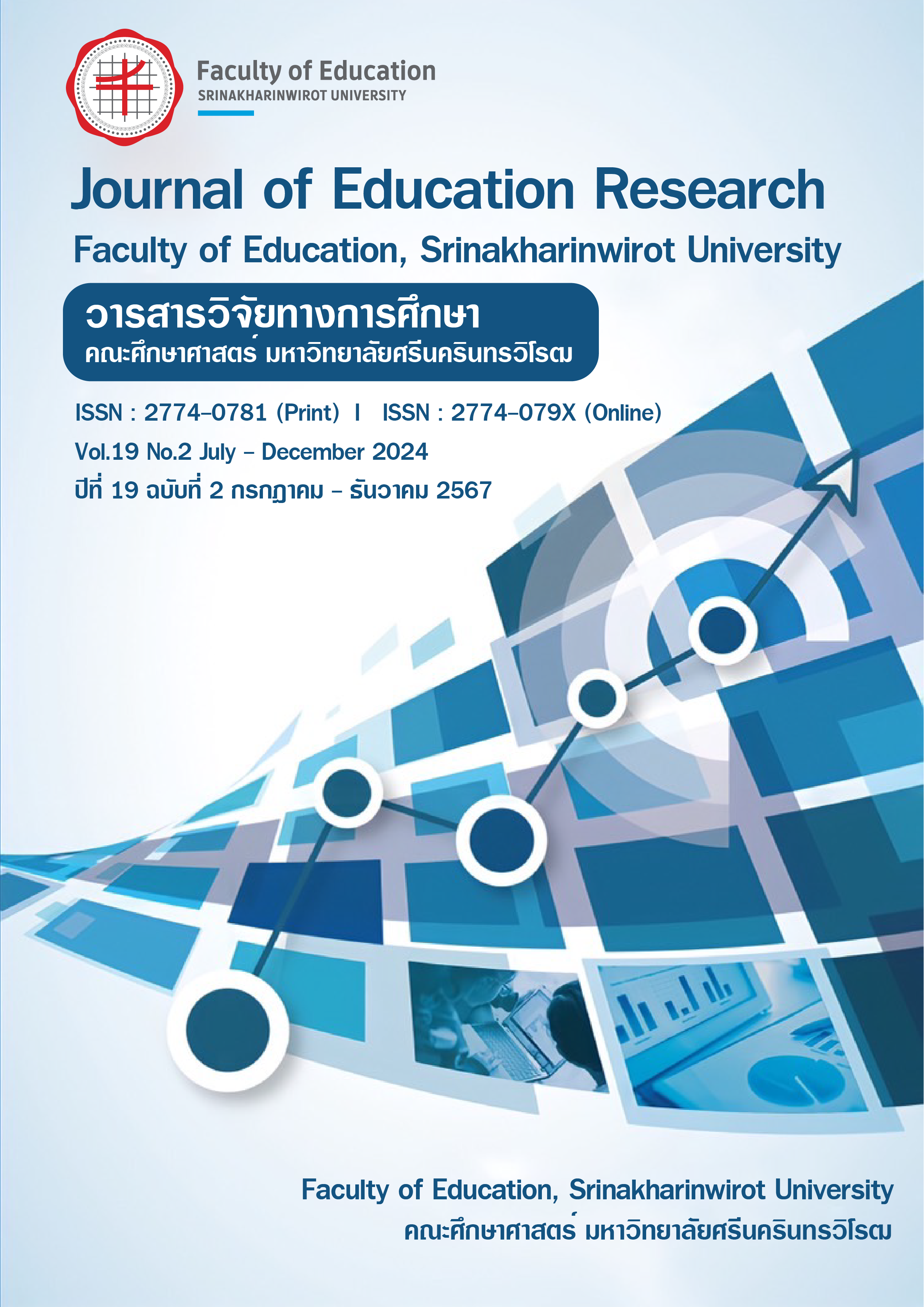รูปแบบการจัดการศึกษาหลักสูตรต่อเนื่องเชื่อมโยงระดับการศึกษาขั้นพื้นฐาน จังหวัดเชียงราย
คำสำคัญ:
การจัดการศึกษาต่อเนื่องเชื่อมโยง, รูปแบบการจัดการศึกษา, การศึกษาขั้นพื้นฐานบทคัดย่อ
งานวิจัยนี้มีวัตถุประสงค์ ดังนี้ 1) เพื่อศึกษาสภาพและแนวการจัดการศึกษาหลักสูตรต่อเนื่องเชื่อมโยงระดับการศึกษาขั้นพื้นฐาน จังหวัดเชียงราย 2) เพื่อสร้างรูปแบบการจัดการศึกษาหลักสูตรต่อเนื่องเชื่อมโยงระดับการศึกษา ขั้นพื้นฐาน จังหวัดเชียงราย งานวิจัยนี้เป็นการวิจัยแบบผสมผสานวิธี ทำการศึกษาจากกลุ่มตัวอย่าง ผู้อำนวยการสถานศึกษาขั้นพื้นฐาน จำนวน 418 คน ได้มาโดยการสุ่มตัวอย่าง แบบชั้นภูมิ เครื่องมือที่ใช้ในการวิจัยมี 3 ชนิด ได้แก่ 1) แบบสอบถาม 2) แบบวิเคราะห์เอกสารการศึกษาพหุกรณี และ 3) แบบสัมภาษณ์ชนิดกึ่งโครงสร้างวิเคราะห์ข้อมูลการวิจัยเชิงปริมาณโดยใช้ค่าเฉลี่ยและส่วนเบี่ยงแบนมาตรฐาน ส่วนการวิจัยเชิงคุณภาพใช้การวิเคราะห์เนื้อหาแล้วเขียนบรรยายเชิงพรรณนา ผลการวิจัย พบว่า 1. สภาพการจัดการศึกษาหลักสูตรต่อเนื่องเชื่อมโยงระดับการศึกษาขั้นพื้นฐาน จังหวัดเชียงราย ในภาพรวมมีระดับการดำเนินการ ระดับมาก เมื่อพิจารณารายด้าน เรียงลำดับจากมากไปน้อย พบว่า ด้านการใช้หลักสูตร ด้านการประเมินหลักสูตร และด้านการสร้างหลักสูตร ตามลำดับ สำหรับแนวทางการจัดการศึกษาหลักสูตรต่อเนื่องเชื่อมโยงระดับการศึกษาขั้นพื้นฐาน พบว่า ประกอบด้วย การเตรียมความพร้อม การจัดทำหลักสูตร การใช้และการบริหารหลักสูตร และการนิเทศกำกับติดตามและประเมินหลักสูตร 2. รูปแบบการจัดการศึกษาหลักสูตรต่อเนื่องเชื่อมโยงระดับการศึกษาขั้นพื้นฐาน จังหวัดเชียงราย ประกอบด้วย 7 องค์ประกอบ ได้แก่ 1) หลักการ ประกอบด้วย พระราชบัญญัติกองทุนเพื่อความเสมอภาคทางการศึกษา พ.ศ.2561 และหลักความร่วมมือ (Cooperation) 2) วัตถุประสงค์ เพื่อพัฒนาผู้เรียนด้านทักษะอาชีพ ทักษะชีวิต และสร้างทางเลือกในการประกอบอาชีพที่หลากหลาย 3) ปัจจัยนำเข้า ประกอบด้วย 3.1) ผู้บริหารสถานศึกษา และบุคลากร 3.2) หน่วยงานทางการศึกษาขั้นพื้นฐานอาชีวศึกษา และอุดมศึกษา 3.3) งบประมาณ 3.4) หลักสูตรต่อเนื่องเชื่อมโยง 4) กระบวนการ ประกอบด้วย 4 ขั้น ได้แก่ ขั้นเตรียมความพร้อม ขั้นการจัดทำหลักสูตร ขั้นการใช้และบริหารหลักสูตร และขั้นนิเทศ กำกับ ติดตาม และประเมินหลักสูตร 5) ผลลัพธ์ การจัดการศึกษาที่สนองต่อผู้เรียนด้านทักษะอาชีพ ทักษะชีวิต มีทางเลือก และโอกาสการประกอบอาชีพที่หลากหลาย 6) ผลกระทบ ประกอบด้วย 6.1) ผู้เรียนมีทักษะอาชีพ ทักษะชีวิต มีทางเลือกและมีโอกาสประกอบอาชีพที่หลากหลาย 6.2) ครูได้รับการพัฒนา การจัดการเรียนรู้ด้านทักษะอาชีพให้แก่ผู้เรียน 6.3) สถานศึกษา และสถานประกอบการ มีเครือข่ายความร่วมมือในการพัฒนาผู้เรียนให้มีทักษะอาชีพที่ตรงกับความต้องการของตลาดแรงงาน และ 7) ปัจจัยแห่งความสำเร็จ ประกอบด้วย การได้รับการสนับสนุนจากหน่วยงานการศึกษาขั้นพื้นฐาน อาชีวศึกษา และอุดมศึกษา อย่างต่อเนื่อง ซึ่งมีผู้ทรงคุณวุฒิประเมินความเหมาะสมอยู่ในระดับมากที่สุด ข้อค้นพบจากการวิจัยนี้ ผู้บริหารสถานศึกษาสามารถนำผลการวิจัยไปปรับใช้ในการจัดหลักสูตรต่อเนื่องเชื่อมโยง สำนักงานเขตพื้นที่การศึกษาและสำนักงานคณะกรรมการการศึกษาขั้นพื้นฐาน สามารถนำผลการวิจัยนี้ไปกำหนดนโยบายเพื่อจัดการศึกษาหลักสูตรต่อเนื่องเชื่อมโยงการศึกษาขั้นพื้นฐานของสถานศึกษาในสังกัด
เอกสารอ้างอิง
กระทรวงศึกษาธิการ. (2565). ประกาศกระทรวงศึกษาธิการ เรื่อง นโยบายและจุดเน้นของกระทรวงศึกษาธิการ ประจำปีงบประมาณ พ.ศ. 2567. กรุงเทพฯ.
คำภีร์ สุดแท้. (2553). การพัฒนารูปแบบการบริหารงานวิชาการสำหรับโรงเรียนขนาดเล็ก. วิทยานิพนธ์ปริญญาดุษฎีบัณฑิต. มหาสารคาม : มหาวิทยาลัยราชภัฏมหาสารคาม.
ชนกนารถ ชื่นเชย. (2550). รูปแบบการจัดการศึกษาต่อเนื่องในสถาบันอุดมศึกษาเอกชน. วิทยานิพนธ์ การศึกษาดุษฎีบัณฑิต. กรุงเทพฯ : สาขาวิชาการศึกษาผู้ใหญ่. มหาวิทยาลัยศรีนครินทรวิโรฒ.
ณรงค์ โพธิ และณัฐธยาน์ โพธิ. (2565). การพัฒนาหลักสูตรต่อเนื่องเชื่อมโยงการศึกษาขั้นพื้นฐานกับอาชีวศึกษาและอุดมศึกษาในพื้นที่รับผิดชอบของสำนักงานศึกษาธิการ ภาค 2. สำนักงานศึกษาธิการภาค 2 สำนักงานปลัดกระทรวงศึกษาธิการ ปทุมธานี.
บุญชม ศรีสะอาด. (2545). การวิจัยเบื้องต้น. พิมพ์ครั้งที่ 7. กรุงเทพฯ: สุวีริยาสาส์น.
มีนา แซ่ลิ้ม. (2560). การประเมินหลักสูตรการศึกษานอกระบบระดับการศึกษาขั้นพื้นฐานพุทธศักราช 2551 ระดับมัธยมศึกษาตอนต้น (ฉบับปรับปรุง พุทธศักราช 2555) ศูนย์การศึกษานอกระบบและการศึกษาตามอัธยาศัย อำเภอเมืองสมุทรปราการ. วิทยานิพนธ์ศึกษาศาสตรมหาบัณฑิต. นนทบุรี : สาขาวิชาการประเมินการศึกษ. มหาวิทยาลัยสุโขทัยธรรมาธิราช.
ไมตรี บุญทศ. (2554). การพัฒนารูปแบบการบริหารเพื่อการประกันคุณภาพภายในที่ส่งผลต่อคุณภาพโรงเรียน สังกัดสำนักงานคณะกรรมการการศึกษาขั้นพื้นฐาน. วิทยานิพนธ์ครุศาสตรดุษฎีบัณฑิต สาขาวิชาการบริหารการศึกษา มหาวิทยาลัยราชภัฏอุบลราชธานี.
ระภีพรรณ ร้อยพิลา. (2562). รูปแบบและแนวทางการพัฒนาหลักสูตรต่อเนื่องเชื่อมโยงการศึกษาขั้นพื้นฐานกับอาชีวศึกษาและอุดมศึกษาในพื้นที่สำนักงานศึกษาธิการภาค 11. วารสารการบริหารการศึกษาและภาวะผู้นำ, 8(29).
วีระ บัวผัน. (2563). รูปแบบการพัฒนาวัฒนธรมองค์การสู่ความเป็นเลิศของสถานศึกษา สังกัดสำนักงานเขตพื้นที่การศึกษาประถมศึกษากำแพงเพชร เขต 1. วิทยานิพนธ์ปริญญาดุษฎีบัณฑิต, มหาวิทยาลัยราชภัฏกำแพงเพชร, กำแพงเพชร.
สำนักงานคณะกรรมการพัฒนาการเศรษฐกิจและสังคมแห่งชาติ. (2561). ยุทธศาสตร์ชาติ 20 ปี (พ.ศ. 2561-2580). พิมพ์ครั้งที่ 1. กรุงเทพฯ.
สำนักวิชาการและมาตรฐานการศึกษา สำนักงานคณะกรรมการการศึกษาขั้นพื้นฐาน กระทรวงศึกษาธิการ. (2553). แนวทางการบริหารจัดการหลักสูตร ตามหลักสูตรแกนกลางการศึกษาขั้นพื้นฐาน พุทธศักราช 2551. (พิมพ์ครั้งที่ 2). กรุงเทพฯ: โรงพิมพ์ชุมนุมสหกรณ์การเกษตรแห่งประเทศไทย.
สุนันทา แก้วสุข. (2553). รูปแบบการดำเนินการประกันคุณภาพการศึกษาที่ผ่านการประเมินในระดับดี : กรณีศึกษามหาวิทยาลัยราชภัฎนครปฐม. วิทยานิพนธ์การศึกษาดุษฎีบัณฑิต มหาวิทยาลัยบูรพา.
อัยรินทร์ ธนอริยมินทร์. (2562). การศึกษาการมีส่วนร่วมของภาคีเครือข่ายในการบริหารจัดการหลักสูตรต่อเนื่องตามการรับรู้ของครู สังกัดสำนักงานส่งเสริมการศึกษานอกระบบและการศึกษาตามอัธยาศัย จังหวัดอ่างทอง. ปริญญาครุศาสตรมหาบัณฑิต. พระนครศรีอยุธยา : สาขาวิชาการบริหารการศึกษา. มหาวิทยาลัยราชภัฏพระนครศรีอยุธยา.
Good, C.V. (1973). Dictionary of Education. (4th ed). New York: McGraw-Hill Book.
Good, V. Carter. (1959). Dictionary of Education. New York: McGraw-Hill Book Company.
Taba, H. (1962). Curriculum Development Theory and Practice. New York: Harcourt, Brace and World.
ดาวน์โหลด
เผยแพร่แล้ว
รูปแบบการอ้างอิง
ฉบับ
ประเภทบทความ
สัญญาอนุญาต

อนุญาตภายใต้เงื่อนไข Creative Commons Attribution-NonCommercial-NoDerivatives 4.0 International License.



